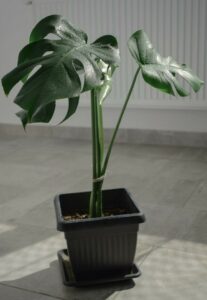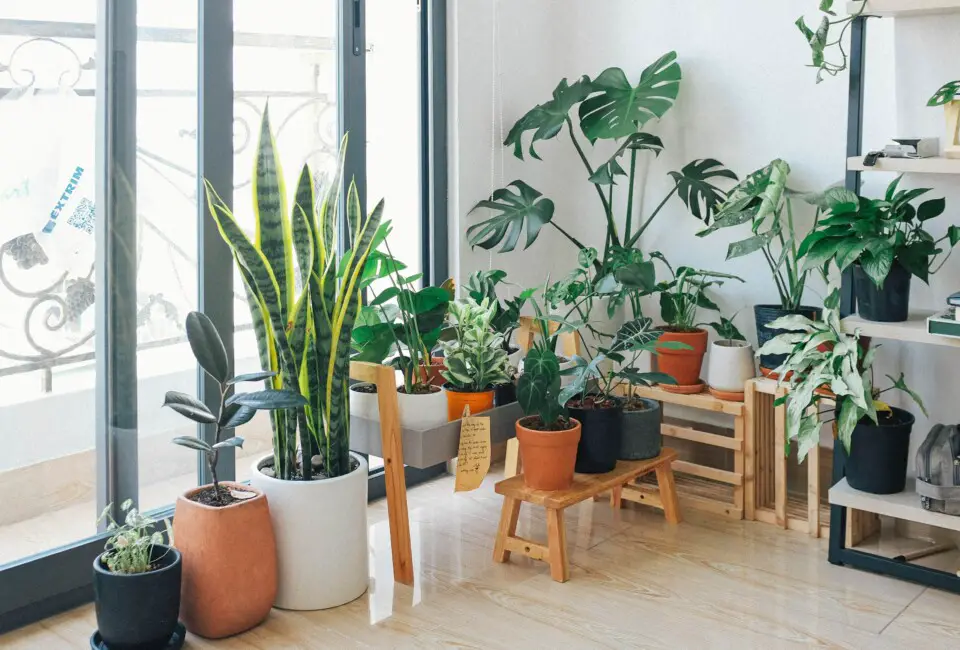Some links in the post are affiliate links and I get a commission from purchases made through some links found in the post.
When I first got my monstera, it wasn’t as big of a deal as it is now. But over the years, the number of people requesting monstera cuttings and care advice increased.
It got to a point where I would run out of cuttings as I did not want to prune my monsteras too much.
Nor did I want to grow more monsteras because I was not selling the cuttings – adding more plants did not make sense.
I knew why I loved my majestic monstera but could not help but wonder why so many other people shared this interest. Was it a trendy thing that would fade away over time?
Or was this a shift in gardening that would shape our relationship with houseplants for decades to come?
The reason a monstera is so popular is due to their eye catching features, having a catchy name, it being low maintenance, they are great focal points, they are very rewarding, they are trendy and they are easy to grow.
I wrote a short guide on why is a monstera so popular and the species that have grabbed the attention of gardeners worldwide.
When Did the Monstera Become Popular?
 As I said, the monstera was not such a big hit when I got mine. So, when it started popping up in art, accessories, home décor, and more, I was curious as to what had caused this change.
As I said, the monstera was not such a big hit when I got mine. So, when it started popping up in art, accessories, home décor, and more, I was curious as to what had caused this change.
It turns out that this was not the first time the monstera had been the plant of the season. Its popularity dates to the 50s and 70s, when it was the plant of choice.
At the time, houseplants had become the trend, and the monstera had clinched one of the top positions. So, designers and artists were fast to include it in their work.
Decades later, people started phasing out houseplants, and with that change, the monstera also lost part of its touch. But come the 21st century, the plant regained its popularity and has blown up so much that it is trending.
Why is the Monstera So Popular?
The monstera species is native to tropical America. But now, you can find it almost anywhere in the world. All it needs is sufficient lighting, regular watering, and enough nutrients, and the plant thrives.
But what has made it such a go-to for gardeners and designers? Why has it spread so much that it now classifies as a mildly invasive species in Seychelles?
Below are some strong points:
1) They Have Unique Features
The first thing that catches your eye with monsteras is their fenestrations. They have beautiful splits on their broad leaves, making these plants even more inviting.
Moreover, they have a tropical vibe to them. You can still enjoy those beachy vibes even when you cannot take a week off work to head down to the beach. And that’s with the simple action of planting a monstera.
The other thing that makes them so special is their aerial roots. These plants survive in the wild by attaching to tree trunks using these roots.
And once you catch a glimpse of these roots wrapped around your choice of moss pole, many things start to make sense. It’s hard to find a plant like a monstera – which is essentially the gift that keeps on giving.
And the third point that has propelled the popularity of this plant is how distinctive it is. In the past, I would have trouble distinguishing different plants because so many of them closely resemble each other.
Then I came across the monstera – there was no doubt that it was a monstera, and I could not be happier for it.
Owning a plant that is unique enough to carve out a niche for itself feels fantastic. And I get why other people would want a piece of the action.
Do you want to know the best part? As monsteras age, they start showing larger fenestrations with broader leaves.
Thus, the more the plant ages, the more aesthetically pleasing it becomes, and that is something worth looking forward to!
2) Their Name is Catchy
Regardless of the monstera variety you have in your home, you likely call it a monstera.
I refer to mine as a monstera, and when we get into the scientific bits, I add the deliciosa part. This name has won this plant a place in people’s names for various reasons.
To start with, it captures the size of the plant uniquely. After all, the monstera gives rise to broad leaves that ignite visual interest.
It’s safe to say that the leaves are the most eye-catchy sections of this plant. But its fast growth is also worth mentioning as this plant often grows several feet tall, twined around a pole, or creeping on the ground.
Thus, the term monstera is quite fitting. Secondly, while close to monster, this name has a warm note. Often, people would walk away from monsters – afraid that anything that goes by that name would harm them.
But monsteras are such open plants. You almost feel like they love you back, owing to their broad and welcoming leaves. We all want a warm monster, which the monstera offers.
Finally, it’s easy to remember this name. Monstera – what an easy name to learn! And that opens up a wide array of resources available to you marked under this name.
3) They Have Low Maintenance
If you have many houseplants like me, you know that high-maintenance plants can be time-consuming.
I keep away from plants that require me to measure their water to the very drop or keep checking their temperature and whatnot.
And luckily, the monstera is a very forgiving plant. Sometimes, I forget to water mine for a few days, and nothing happens. Sure, the soil feels dry, and the magnificent leaves may start wilting, but that’s about it.
Here’s a crash course on caring for monsteras.
- Water the plant when the top inch of soil is dry,
- Leave them in bright and indirect light and avoid direct sun exposure, and
- Repot them every two years to give them more nutrients and keep them from becoming rootbound.
If you follow these simple rules, the plant will thrive and fenestrate once it matures. And once it establishes, it can even withstand neglect without dying.
But if you don’t follow those rules, you will put your plant at risk of pest infestations, heat stress, and more. While the plant is easy to care for, you need to put in some work for it to be as beautiful as the plants you see in nurseries.
For a full care guide on a monstera, check out the article we created here.
4) They Are Focal Points

What do you use for visual interest in your home? Sometimes, people go with lights. At others, they choose to work with curated art pieces that can spark conversations.
And the more we declutter our spaces and lean onto minimalism with an indoor-outdoor touch, plants have become the focal points.
Take the monstera as one example. This plant has so many factors working in its favor. It grows big enough to command attention in any room.
Whether decorating an office, bedroom, or living room, you can always find a place for it. All you need is to choose the bland space in the room, squeeze in a monstera, and voila, you have made magic.
Add the fact that it has a dramatic effect. The monstera is one plant with a high return on effort. Usually, you can spend years catering to a plant only for it to reach a few inches or feet.
But a monstera rewards your time with growth and always grows wider and is happy to unfurl a new leaf occasionally.
This aesthetic is a key conversation starter with people gazing at the plant and asking how you’ve achieved such growth.
Most plants have the downside of looking busy when used as focal points. The monstera, while dramatic, does not have this effect.
It stands tall and proud, showcasing its fenestrations on its smooth green leaves. This plain stance is breath-taking and enables the plant to be subtle and focal.
You can choose which of the two effects you’d like by factoring in some accessories.
5) They Are Rewarding
Few plants give me the satisfaction I get from caring for my monsteras. These giant plants are eager to please and grow in leaps and yards.
Their leaves never disappoint and grow into fenestrated broad leaves with an appealing green hue. I am always in awe of how one plant can be so beautiful.
And looking at online discussions about why people love the monstera, I can tell this is a shared motivation.
While most plants will reciprocate care with growth, it is not always as evident as the monstera. These grow so big that they even start looking human-like.
I have come across people who perceive these plants as their babies or pets. And I get it because monsteras do not hold back on that ‘alive’ factor. It almost feels like I am raising kids.
6) They Are the Trend
If you had thought that the monstera wave had anything to do with current trends, you are right on the money.
At first, they made a comeback because people growing up in the 50s and 70s wanted something that reminded them of their childhood.
That nostalgia was a key motivator towards their propagation. But then marketers caught up with the plants and realized how well the market would respond to them.
So, they launched a series of ad campaigns highlighting the beauty of these plants. And soon enough, social media was full of monstera pictures.
Nurseries were now propagating the monsteras at a fast rate and were quick to offer them as options to newbies.
And in what seemed like a hot second, monsteras became the it plant. These plants are Instagrammable, Pinterest-worthy, and bear many other social proof factors. And that has made them quite the go-to choice.
There has also been an increased interest in the variegated monsteras. These are hard to come by because they result from lab work or mutations.
And when something is this hard to find, it gains a lot of relevance, increasing awareness of this beauty.
7) They Are Easy to Grow
I mentioned that I share my monstera cuttings with my loved ones often. Usually, I do this after pruning the plants. Or when I split the roots and derive a couple of other plants.
The recipients then root the monsteras in water or soil, and in a few weeks, they move the monsteras to pots and start growing them.
That’s how easy it is to grow monsteras, which has benefited their popularity.
After all, not many people would consider growing a species that is hard to root or grow. And once you add that these plants are easy to care for, you have a winner!
What Are the Most Popular Monstera Varieties?
 The monstera has over 50 species! And that’s the fun of it all because you can choose what to grow in your home.
The monstera has over 50 species! And that’s the fun of it all because you can choose what to grow in your home.
I grow the monstera deliciosa which is one of the more common options. And have realized that most gardeners lean towards the following species:
- Monstera Deliciosa: This plant, also known as the Swiss Cheese Plant, goes by a hoard of other names, including fruit salad plant! It can reach up to 60 feet in the wild with a spread of up to 3 feet. Its fenestrations reach the edge of the leaves.
- Monstera Borsigiana: This plant looks like the deliciosa but with smaller leaves, thinner stems, and a reduced spread. It has a faster growth rate and is an active climber, especially when supported by a moss pole.
- Monstera Adansonii: This plant, which also goes by the name monkey mask, has smaller and thinner leaves than the deliciosa. Moreover, its fenestrations do not reach the leaf edges and remain closed.
- Monstera Peru: This plant gives rise to thick, shiny, and leathery leaves and has one key distinction – no fenestrations! It has a vine-like growth pattern and grows relatively fast when supported on a pole.
- Monstera Dubia: This species, also known as the shingle plant, gives rise to heart-shaped leaves with light and dark green hues in alternating patterns. Once the plant matures, the leaves turn dark green and fenestrate. However, this may not happen when you grow the plant indoors, as the fenestration requires a lot of light.
Other common monsteras include Pinnatipartita, Siltepecana, Standleyana, Acuminata, and Obliqua.
You may enjoy our articles on why are some monstera expensive and what are the rarest monstera varieties.
Final Thoughts
Monsteras are here to stay because their tens of benefits are not going anywhere soon.
These plants will always have a positive aesthetic effect in our homes and outdoors. And if you’ve been holding back for fear that the trend will end, you don’t need to do so anymore.
Happy Gardening!


